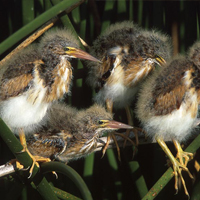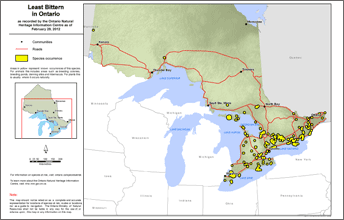Least bittern
Scientific name: Ixobrychus exilis


Cover photos credit: Brian E. Small (left) A. Morris/VIREO (right)
Status
Threatened
“Threatened” means the species lives in the wild in Ontario, is not endangered, but is likely to become endangered if steps are not taken to address factors threatening it.
Date added to the Species at Risk in Ontario List
The Least bittern was already assessed as threatened when the Endangered Species Act took effect in 2008.
What it looks like
The Least bittern is the smallest member of the heron family, reaching only 30 centimetres in length. It has brown and beige plumage with large chestnut patches on its wings.
The crown and back of males is black, but is lighter in females and juveniles. The throat is light tan with whitish streaks and the belly is white. The legs and beak are bright yellow. Young birds look similar to females but the markings are not as bold.
Where it lives
In Ontario, the Least bittern is found in a variety of wetland habitats, but strongly prefers cattail marshes with a mix of open pools and channels.
This bird builds its nest above the marsh water in stands of dense vegetation, hidden among the cattails.
The nests are almost always built near open water, which is needed for foraging. This species eats mostly frogs, small fish, and aquatic insects.
Where it’s been found in Ontario
In Ontario, the Least bittern is mostly found south of the Canadian Shield, especially in the central and eastern part of the province.
Small numbers also breed occasionally in northwest Ontario. This species has disappeared from much of its former range, especially in southwestern Ontario, where wetland loss has been most severe.
In winter, Least bitterns migrate to the southern United States, Mexico and Central America.
View a larger version of this map (PDF)
What threatens it
The main threat to the Least bittern is destruction of its wetland habitat. Shoreline development, wetland loss and drainage, and invasive species are all serious threats.
This species does not generally tolerate human disturbance well (e.g. lighting from buildings, boat wakes in protected channels, loud noise etc.) and will leave marshes if human activity or habitat alteration becomes too great.
Action we are taking
Threatened Species and their general habitat are automatically protected.
Recovery strategy
A recovery strategy advises the ministry on ways to ensure healthy numbers of the species return to Ontario.
Read the recovery strategy (December 14, 2016)
Government response statement
A government response statement outlines the actions the government intends to take or support to help recover the species.
Read the government response statement (September 12, 2017)
Review of progress
A review of progress made toward protecting and recovering a species is required no later than the time specified in the species’ government response statement, or not later than five years after the government response statement is published if no time is specified.
Read the report on progress towards the protection and recovery of 12 species at risk, including Least Bittern (2022).
Habitat protection
General Habitat Protection - June 30, 2013
What you can do
Report a Sighting
The Ministry of Natural Resources and Forestry tracks species at risk such as the Least bittern. You can use a handy online form to report your sightings to the Natural Heritage Information Centre. Photographs with specific locations or mapping coordinates are always helpful.
Volunteer
Volunteer with your local nature club or provincial park to participate in surveys or stewardship work focused on species at risk.
Be a good steward
- private land owners have a very important role to play in species recovery; if you find Least bittern nesting on your land, you may be eligible for stewardship programs that support the protection and recovery of species at risk and their habitats
- invasive species seriously threaten many of Ontario’s species at risk; to learn what you can do to help reduce the threat of invasive species, visit:
- Bird Studies Canada is working to advance the understanding, appreciation and conservation of wild birds and their habitat in Ontario and elsewhere; for more information on how you can help.
- Least bitterns are quite shy and secretive, particularly during the breeding season (May to mid-July), and are easily scared away; try to give them lots of room and distance
Report illegal activity
Report any illegal activity related to plants and wildlife to
Quick facts
- The Least bittern is more likely to be heard than seen in its dense marsh habitat; the typical call given by males is a hollow, quiet “coo-coo-coo”. When alarmed, they can give a harsh “kek-kek-kek” call; they are most vocal in early morning and evening, but could potentially call anytime during the day or night.
- The scientific name for this heron, Ixobrychus, was incorrectly translated from Latin in 1828; it was intended to mean “reed boomer” - a reasonable name given the bird’s call, however if translated literally it really means “greedy eater of Mistletoe".
- Least bitterns generally fly fairly low and as a result are sometimes killed by cars, where roads pass through wetlands; they are also susceptible to collisions with hydro lines, guy wires on towers, or hitting tall buildings that are illuminated at night (when they migrate).
- There is a rare colour variation of this species that was once thought to be a separate species, the Cory’s Least bittern. In the Cory’s, the rich beige areas are replaced by dark brown; while it was known from a number of areas within their range, this form was once regularly encountered in Ontario, especially in the marshes at Ashbridges Bay in east Toronto; sadly, these marshes were destroyed decades ago, and this form is now rarely reported anywhere.
